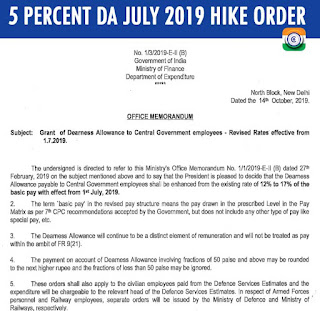7th Pay commission likely to introduce health insurance
New Delhi: In a move that could benefit more than 50 lakh central government employees and 56 lakh pensioners, the Seventh Pay commission is planning to propose to introduce health insurance scheme to replace Central Government Health Scheme (CGHS) at highly subsidized rates.
The pay panel has already held detailed discussions about this with various
stakeholders, including organisations, federations, groups representing
civil employees as well as Defence services.
The pay panel will ask the central government to urge the insurance industry to come up with feasible health insurance solution for the central government employees and pensioners. The IRDA, the insurance regulatory body of India, will be compelled to ask the health insurance companies to offer a basic insurance to every central government employee and pensioner, regardless of age or medical condition and are not allowed to make a profit off this basic insurance.
The serving central government employees in non-CGHS areas are provided healthcare facilities under the CS(MA) Rules, 1994, but pensioners are not covered under these rules.
The pensioners are, however, entitled to a fixed medical allowance of Rs 500 per month. The pensioners residing in non-CGHS areas have the option to become a CGHS member in any CGHS-covered city of their choice to avail the medical facilities under the CGHS Scheme.
Health insurance would be available for central government employees and pensioners till death, with the insured employees and pensioners will have to pay 50% of the premium from their salaries and pensions and the remaining 50% premium may be paid by the central government.
The health insurance would cover a family of six the employee and pensioner himself or herself, the spouse, two children and two parents. The maximum sum assured for family in a year could up to Rs 5 lakh.
Under the CGHS, the annual per capita expenditure is more than Rs 5,000. In contrast, the National Rural Health Mission (NRHM), which caters to the rural masses, spends just Rs 180 per head.
The CGHS is financed mainly through the Centre’s tax revenues. Though beneficiaries do contribute a share of their wages towards premium, ranging from Rs 600 to Rs 6,000 a year depending on their pay scale, this accounts for just about 5 per cent of the total expenditure. The government shells out the remaining 95 per cent.
So, the central government also wanted for ending the CGHS in its current form and to move to an insurance-based health scheme to cut costs.
TST
New Delhi: In a move that could benefit more than 50 lakh central government employees and 56 lakh pensioners, the Seventh Pay commission is planning to propose to introduce health insurance scheme to replace Central Government Health Scheme (CGHS) at highly subsidized rates.
 |
| Seventh Central Pay Commission Chairman Justice Ashok Kumar Mathur |
The pay panel will ask the central government to urge the insurance industry to come up with feasible health insurance solution for the central government employees and pensioners. The IRDA, the insurance regulatory body of India, will be compelled to ask the health insurance companies to offer a basic insurance to every central government employee and pensioner, regardless of age or medical condition and are not allowed to make a profit off this basic insurance.
The serving central government employees in non-CGHS areas are provided healthcare facilities under the CS(MA) Rules, 1994, but pensioners are not covered under these rules.
The pensioners are, however, entitled to a fixed medical allowance of Rs 500 per month. The pensioners residing in non-CGHS areas have the option to become a CGHS member in any CGHS-covered city of their choice to avail the medical facilities under the CGHS Scheme.
Health insurance would be available for central government employees and pensioners till death, with the insured employees and pensioners will have to pay 50% of the premium from their salaries and pensions and the remaining 50% premium may be paid by the central government.
The health insurance would cover a family of six the employee and pensioner himself or herself, the spouse, two children and two parents. The maximum sum assured for family in a year could up to Rs 5 lakh.
Under the CGHS, the annual per capita expenditure is more than Rs 5,000. In contrast, the National Rural Health Mission (NRHM), which caters to the rural masses, spends just Rs 180 per head.
The CGHS is financed mainly through the Centre’s tax revenues. Though beneficiaries do contribute a share of their wages towards premium, ranging from Rs 600 to Rs 6,000 a year depending on their pay scale, this accounts for just about 5 per cent of the total expenditure. The government shells out the remaining 95 per cent.
So, the central government also wanted for ending the CGHS in its current form and to move to an insurance-based health scheme to cut costs.
TST








0 comments:
Post a Comment